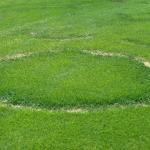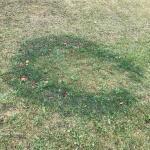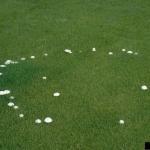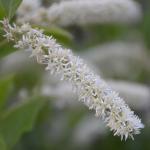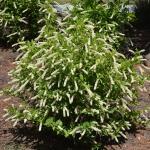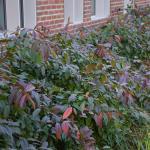A monthly e-newsletter from UMass Extension, published March to October, for home gardeners.
To read the articles in each section of the newsletter, click on the section headings below to expand the content:
Tips of the Month
June is the Month to.....
- Choose tomato cages that are tall enough to provide support over the life of the plant. This is best determined by knowing whether the tomato varieties that you are growing are determinate or indeterminate. Determinate or ‘bush’ varieties are bred to grow to a mature height that is typically 3-4’, while indeterminate varieties will grow throughout the season until limited by frost or other environmental factors. Be aware that many commonly available tomato cages are too short to provide adequate season-long support to even determinate plants. Better to err on the side of cages being too tall rather than too short, and quality cages, tho more expensive, can be used for many years.
- Try bottom-watering tomato plants to help discourage disease infection. Tomatoes are among the most disease-prone vegetable garden plants, and the potential for disease infection increases the longer the leaves are wet. Several common diseases, including early blight and Septoria leaf spot, can significantly reduce tomato plant vigor and yields. Drip irrigation or soaker hoses are common alternatives to overhead watering. Another great practice to help reduce disease in tomato plants is to rotate the location of the plants in the garden from year to year.
- Prune or remove invasive plants before fruit set. A number of invasive plants, such as multiflora rose, burning bush, and Japanese barberry set fruit, and thus seed, in mid to late summer. June is a great time to begin working on hard pruning or outright removal of these species to minimize or prevent seed dispersal. Regardless of whether these plants are actively removed or continue to be maintained ornamentally, prevention of seed dispersal is part of good environmental stewardship.
- Cut stands of Japanese knotweed to the ground. A long-term, non-herbicidal approach to manage stands of Japanese knotweed is repeat cutting or mowing. The idea is that the cutting removes the above-ground portions of the plant, which support the below-ground portions of the plant via photosynthesis. Consistent cutting of the above-ground “support-system” will gradually starve the rhizomes which give rise to new growth, and eventually, the plants will not re-grow. Stands should be cut throughout the season as soon as growth reaches 4-6 inches in height.
- Understand that it may be too late to treat gypsy moth caterpillars with Bacillus thuringiensis ‘Kurstaki’. The best time to treat gypsy moth caterpillars with BtK is when they are smaller than ¾” and actively feeding on foliage. Once the caterpillars grow larger than ¾”, BtK is markedly less effective for control. Unfortunately, the point at which the caterpillars grow larger than ¾” is also the stage when they become most visible to folks, who in turn look for avenues to control them. In case you don’t have a ruler handy, another useful visual indicator that gypsy moth caterpillars are too large to treat is when yellow coloration is present on the head.
- Change water in bird baths at least once a week to discourage mosquito breeding. Standing, still water in bird baths or other water features is a prime location for mosquitoes to lay their eggs, which mature into adults in the span of about a week. Changing the water a minimum of once a week will prevent this cycle from completing. Need a longer-term solution? Install an aerator to eliminate standing water, or seek out ‘dunks’ at your local garden center that contain the insecticidal bacterium Bacillus thuringiensis var. israelensis.
- Do not remove more than 1/3 of the plant height at one time when cutting grass. This is known as the “1/3 rule”, and applies to a range of plant cultural practices from pruning to mowing. The first step is to determine a reasonable mowing height, which is normally about 3 inches for most lawns. The 1/3 rule can then be used to arrive at the ideal mowing frequency. For example, once a lawn mown at 3 inches grows to 4.5 inches, it is time to mow again. Allowing the lawn to grow taller than 4.5 inches before cutting to 3 inches stresses the plants, and mowing to 3 inches before the lawn reaches 4.5 inches is sooner than necessary.
- Allow grass to experience mild drought stress between deep irrigation events. An oft-cited guideline for watering lawns is to water “deeply and infrequently”. Watering deeply most often refers to wetting to the depth of the root zone, which can be 6-8 inches or greater. But how about when to water? The best approach is to wait until the grass plants experience mild moisture stress. Determining mild moisture stress can take a little practice, but common indicators include leaf fold and roll, subtle color change (darker, grayer), and ‘footprinting’ (when footprints from walking across a lawn remain visible). Research has shown that mild moisture stress between irrigation events increases drought resistance, encourages deeper rooting, and leads to greater overall resiliency.
- Know that the appropriate timing of preventive applications for grubs depends on the specific material used. Preventive grub products that contain chlorantraniliprole (e.g. GrubExTM) are best applied between mid-April and very early June in Massachusetts, meaning that the effective application window is rapidly closing for this material. Neonicotinoid materials (e.g. products that contain imidacloprid) take less time to disperse in the soil and are best applied from mid-June to very early August. If choosing a neonicotinoid for preventive grub management, be sure to follow best practices to protect pollinator health; see our fact sheet at ag.umass.edu/turf/fact-sheets/neonicotinoid-turf-insecticides-pollinators
- Put out suet to attract insect-eating birds to the garden. Suet cakes will often draw a range of insect-feeding feathered friends, who will then repay the favor by feasting on insect pests in the garden and landscape. A variety of suet feeder options are readily available, and the suet itself can be purchased pre-made or made at home - numerous recipes are available online, many of which are tailored to appeal to different species of birds.
- Be vigilant about ticks! The summer months are when folks are most likely to be working and playing outdoors in tick habitat, and this corresponds with the time frame in the life cycle of a tick where they are tiny and difficult to detect. These factors in combination greatly increase the probability of coming into contact with ticks and potentially contracting a tick-borne illness such as Lyme disease. First line defenses include treating shoes and clothing with permethrin, applying DEET to exposed skin, showering as soon as possible after being outdoors, and conducting daily tick checks (including pets!).
Jason D. Lanier, UMass Extension Turf Specialist
Timely Topics
Groundcovers
What is a groundcover? Well, very loosely defined, it may be “anything that covers the ground” and helps to hold the soil in place, repress weeds and curb erosion. Examples of non-living ground covers might be mulch, paving stone, crushed stone, artificial turf, etc., which will certainly do the trick and cover the ground.
However, when most people think of groundcovers, they probably are thinking of low-growing, spreading, commonly used plants like English ivy, Pachysandra terminalis, Convallaria majalis (Lily-of-the-valley) and Vinca minor. Yet, there are so many other plants that can be used as groundcovers and some of them are not low-growers.
When selecting a groundcover, as when selecting any plant, choose “the right plant for the right location”. Many groundcovers can grow in an aggressive manner and may fill or colonize an area and continue to do so, year after year. While some of these aggressive growers may not be considered a Massachusetts invasive plant (see the Massachusetts Prohibited Plant List), they 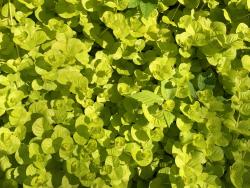 certainly have the capability of outgrowing other plants in their way and may grow into lawns, overtake desirable perennials, escape into wooded natural areas, etc. Plants like English ivy, Pachysandra terminalis, Convallaria majalis (Lily-of-the-valley), Vinca minor, and Lamium maculatum, while good groundcovers, are a few of the aggressive groundcovers that may become problematic in a small garden area. Another commonly used groundcover, Lysimachia nummularia (Creeping Jenny), including the gold form, Lysimachia nummularia ‘Aurea’ (see photo), is on the Massachusetts Invasive Plant List.
certainly have the capability of outgrowing other plants in their way and may grow into lawns, overtake desirable perennials, escape into wooded natural areas, etc. Plants like English ivy, Pachysandra terminalis, Convallaria majalis (Lily-of-the-valley), Vinca minor, and Lamium maculatum, while good groundcovers, are a few of the aggressive groundcovers that may become problematic in a small garden area. Another commonly used groundcover, Lysimachia nummularia (Creeping Jenny), including the gold form, Lysimachia nummularia ‘Aurea’ (see photo), is on the Massachusetts Invasive Plant List.
Many plants are designated as a “groundcover” because they are able to spread easily by underground stems, rhizomes, etc. to cover large areas of ground, smothering weed seeds, etc. Other plants may be clump-formers and slowly spread out to cover an area. So, whatever plants you choose, make sure that the area you want to cover is large enough for the particular plants you select. Also, especially if it is a non-native, aggressive-growing groundcover, try not to plant it near minimally managed landscapes. In other words, don’t plant an aggressive plant like English ivy, near a natural woodland or an area where native plants are growing; it may quickly and/or eventually take over that area.
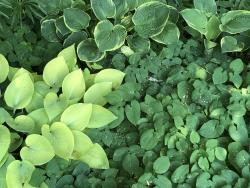 Groundcovers are often used in areas that are considered problematic, like shady areas where turfgrass and plants that require full sun won’t grow. Groundcovers can be used on slopes to slow erosion and rainwater, or in areas where people want to reduce the lawn area. Groundcovers can be mass-planted or grown with other groundcovers with similar growing requirements for a ‘tapestry effect’ (see photo). Many groundcovers are low maintenance, drought tolerant and do not have significant disease or insect problems.
Groundcovers are often used in areas that are considered problematic, like shady areas where turfgrass and plants that require full sun won’t grow. Groundcovers can be used on slopes to slow erosion and rainwater, or in areas where people want to reduce the lawn area. Groundcovers can be mass-planted or grown with other groundcovers with similar growing requirements for a ‘tapestry effect’ (see photo). Many groundcovers are low maintenance, drought tolerant and do not have significant disease or insect problems.
Below are just some of the many low maintenance ground covers that are available.
Herbaceous (non-woody) Deciduous Groundcovers
Unless stated otherwise, plant in a moisture retentive, well-drained soil. Most plants will not do well in poorly-drained or heavy clay soils.
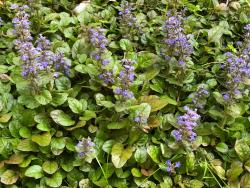 Ajuga reptans – Bugleweed.
Ajuga reptans – Bugleweed.
Many cultivars. Low, growing, mat-forming groundcover.
May be planted as part of a low maintenance lawn, as it will
tolerate foot traffic and being mown over. Can spread very aggressively. Pink, white or blue flowers, depending on cultivar. Full-sun to partial shade.
Hardy to Zone 3.
 Anenome canadensis – Canada Anenome.
Anenome canadensis – Canada Anenome.
Native. Aggressive ground cover;
1 to 2 feet high and wide-spreading.
White flowers appear in May – June.
Full sun to part shade.
Hardy to Zone 3.
Asarum canadense - Wild Ginger. Native. Part shade to full shade; 6-inch wide, dark green, kidney-shaped basal leaves that appear to hug the ground. Slowly forms colony. Hardy to Zone 4.
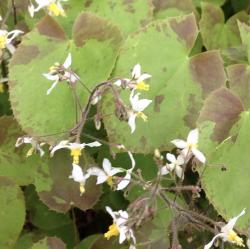 Epimedium spp. – Barrenwort.
Epimedium spp. – Barrenwort.
Many cultivars with various heights
ranging from 4 inches to 24 inches high.
Lovely spring flowers in many shades: yellow, red, pink lavender, white etc. Green, sometimes splashed with burgundy or white, elongated-heart-shaped foliage;
average well-drained soil; partial shade to full shade;
will tolerate drought.
Hardy to Zone 5.
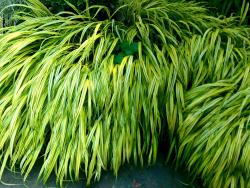 Hakonechloa macra – Japanese forest grass.
Hakonechloa macra – Japanese forest grass.
Bright green leaves 10 to 12 inches long.
Part shade; graceful, non-invasive grass, forming arching mounds; cultivars including ‘Aureola’ (gold foliage stripe with green striping); ‘Aurea’ (Gold); ‘Variegata’ (green foliage with white striping). Good for massing.
Hardy to Zone 5.
Hosta - Hosta. Thousand of cultivars varying in height and width; many tolerant of sun, as well as shade. Mass plant alone or with other partial shade tolerant plants. Hardy to Zone 3.
Pachysandra procumbens – Allegheny pachysandra. Native. Round, mid-green leaves; grows 8 to 12 inches high and is wide spreading; dappled shade to partial to full shade; well-drained organic, moisture retentive soil. May be used on slopes. Hardy to Zone 5.
Phlox stolonifera – Creeping phlox. Native. Low-growing, spreading, mat-forming groundcover 8 inches high, with fragrant, flowers (lavender; white), blooming in May. Full sun – part shade. Hardy to Zone 5.
Waldsteinia ternata – Barren strawberry. Native. Low-growing, 4 to 6 inches high. Bright green, strawberry-like foliage; yellow flowers in April-May. Full sun to part shade; Forms wide carpet of foliage. Hardy to Zone 4.
Woody Evergreen Groundcovers
Arctostaphylos uva-ursi – Bearberry. Native. 6 to 12 inches tall and spreads to form large mats. Small shiny, dark green leaves; small (1/4 inch) whitish-pink drooping flowers in April – May, followed by small cranberry-like fruit which turn red in the fall. Full sun; will tolerate partial shade; does not tolerate poor drainage or heavy, alkaline soils. Will tolerate sandy, rocky soils. Drought and salt tolerant; may be used on slopes. Hardy to Zone 2.

Microbiota decussata – Russian arborvitae. 1.5 to 2 feet tall, with a spreading, mounding habit.
The green-needled foliage, turning purplish-green in winter, is similar to Juniper, with fewer problems. Prefers full sun, well-drained soils and is drought tolerant. May be used on slopes.
Tower Hill Botanic Garden Cary Award Winner. Hardy to Zone 2.
Woody Deciduous Groundcovers
Comptonia peregrina – Sweetfern. Native. Full sun and will tolerate partial shade; Grows best in well-drained, sandy soils; does not tolerate poorly drained or heavy soils. Salt tolerant. 3 to 5 feet tall and spreads by suckers. May be used to stabilize slopes. Hardy to Zone 2.
Rhus aromatica ‘Gro-low’ - ‘Gro-low’ fragrant sumac. Native. 2 to 4 feet tall and wide-spreading. Full sun - partial shade. Soil and site adaptable; prefers well-drained organic soils; full sun partial shade. Drought tolerant. May be used to stabilize slopes. It is a non-poisonous plant. Tower Hill Botanic Garden Cary Award Winner. Hardy to Zone 3.
Stephanandra incisa ‘Crispa’ - Cutleaf Stephanandra. Native to Japan and Korea. 1 to 2 feet tall and wide-spreading. Full sun - partial shade. Acidic, moisture retentive, well-drained soils. Full sun to light shade. May be used to stabilize slopes. Hardy to Zone 4.
Xanthorhiza simplicissma - Yellowroot. Native. A low growing deciduous woody shrub to 2 feet high and wide-spreading; tolerant of sun, shade and wet soil; may be used on slopes. Hardy to Zone 5.
Although many people probably do not think of turfgrasses as groundcovers, they actually are and the subject of groundcovers cannot be ended without acknowledging them. Turf is one of the best and most well-known groundcovers for reducing runoff, erosion, etc. See the Benefits of Turf Grass at https://www.nps.gov/subjects/turfmanagement/benefits.htm
Turf provides a green aesthetic to the landscape and is highly regarded by many people. For others, turf may be regarded as “high maintenance”, or high-input, when it comes to mowing, fertilizing, pest management, etc. and they may want to reduce that lawn area with other groundcovers. However, there are low-input turf options for people who want a low-maintenance lawn. For more details, see these UMass Extension fact sheets:
Remember, there are many, many plants available for numerous planting situations. Seeking out some of the less common sustainable plants may open up many more landscape planting opportunities.
Deborah C. Swanson, Horticulturist
News for Gardeners
Glyphosate: Review of research related to risks
Many readers are most likely aware that in early 2015, the World Health Organization’s (WHO) International Agency for Research on Cancer (IARC) evaluated the potential carcinogenic risks to humans of several pesticides, including glyphosate. After that meeting the IARC panel classified glyphosate in Category 2A (note: red meat is also included in Category 2A). This finding was rather surprising as glyphosate has a long history of safe use.
In evaluations spanning four decades, the overwhelming conclusion of experts worldwide has been that glyphosate, when used according to label directions, does not present an unreasonable risk of adverse effects to humans, wildlife or the environment. The United States scientific research and regulatory communities strongly disagreed and were suspicious of the IARC’s classification of glyphosate. These groups believed that IARC overlooked decades of thorough and science-based analysis by regulatory agencies around the world and selectively interpreted data to arrive at its classification.
No regulatory agency in the world considers glyphosate to be a carcinogen. Since IRAC’s classification of glyphosate, regulatory agencies have reviewed all the key studies examined by IARC – and many more – and arrived at the overwhelming consensus that glyphosate poses no unreasonable risks to humans or the environment when used according to label instructions. Regulatory authorities in the United States, Europe, Canada, Japan, New Zealand and Australia have publicly reaffirmed that glyphosate does not cause cancer.
The Food and Agriculture Organization (FAO) is the oldest permanent specialized agency of the United Nations. In May of 2016, the Joint FAO/WHO Meeting on Pesticide Residues (JMPR) concluded that “glyphosate is unlikely to pose a carcinogenic risk to humans from exposure through the diet.” In an attempt to better understand how IARC arrived at such an inconsistent conclusion, the primary manufacturer of glyphosate retained a scientific consultant to convene an expert panel to review IARC’s assessment. The charge to this panel of experts was to take a thorough look at the data in the monograph, assess the scope of the research included or excluded, and publish their conclusions to allow for external review. The panel concluded that “the data does not support IARC’s conclusion that glyphosate is a ‘probable human carcinogen’ and, consistent with previous regulatory assessments, further concluded that glyphosate is unlikely to pose a carcinogenic risk to humans.”
In October of 2017, Reuters reported on recent activities on the topic of glyphosate and IRAC’s classification. Below is a brief summary and a link for the full story published by Reuters.
In Glyphosate Review, IARC Edited Out 'Non-Carcinogenic' Findings By Kate Kelland, Reuters. October 19, 2017
The World Health Organization’s cancer agency dismissed and edited findings from a draft of its review of glyphosate that were at odds with its final conclusion that the chemical probably causes cancer. Documents seen by Reuters show how a draft of a key section of the International Agency for Research on Cancer’s (IARC) assessment of glyphosate - a report that has prompted international disputes and multi-million-dollar lawsuits - underwent significant changes and deletions before the report was finalized and made public. Reuters found 10 significant changes that were made between the draft chapter on animal studies and the published version of IARC’s glyphosate assessment. In each case, a negative conclusion about glyphosate leading to tumors was either deleted or replaced with a neutral or positive one. For more information read the full report here .
Randy Prostak, UMass Extension Weed Specialist
Trouble Maker of the Month
Fairy Rings on Lawns
When fairy rings occur, they typically appear as rings or arcs in lawn turf. Rings can vary in diameter from a few inches to several feet. They often arise in the case of fairly recent lawn construction where organic matter such as tree stumps, large roots, or landscaping debris have been buried, once the turf begins to mature.
Fairy rings normally appear in spring or summer and can be caused by at least 60 different species of fungi. These fungi do not parasitize turf, but instead live on organic matter in the soil. Their activity can alter soil conditions and have a noticeable effect on a lawn.
There are three general types of fairy rings:
- Type 1 is characterized by areas of dead turf. These areas are sometimes bordered by turf that is greener than the surrounding turf, and may or may not also contain mushrooms.
- Type 2 contains no dead turf, but consists of a dark green ring of grass that stands out against the surrounding turf. This type also may or may not contain mushrooms.
- Type 3 consists solely of mushrooms, without any noticeable effect on nearby turf.
The fungal mycelium grows as an extensive network underground, and the activities of this network can have different effects on the surrounding turf.
An abundance of mycelium in the soil can make it hydrophobic, meaning that the soil repels water, preventing percolation into the root zone. Because of this condition, the associated turf can begin to suffer from drought stress even when soil moisture is abundant. This phenomenon is sometimes referred to as localized dry spot. The ring itself may be formed by dead or dormant grass, and turf may also die in patches inside or just outside of the ring. The fungal mycelium may also deplete the soil of nutrients, further weakening the turf. Some fairy rings produce hydrogen cyanide, which is toxic to turf.
As they break down organic matter, some fungi release nitrogen into the soil, and turf in or near the edges of these rings may grow more vigorously and have a darker green color as a result. In some cases, excess nitrogen may build up in the soil and lead to ammonium toxicity, which can stunt or kill turfgrass plants.
Other fairy ring fungi go about their business quietly and no symptoms or signs are observed on the lawn until mushrooms appear above the soil surface. Mushrooms are fungal reproductive structures. Copious spores are produced in or on the mushroom and dispersed by wind.
Management of fairy rings can be challenging, but there are several cultural management practices that can be helpful:
- Manage thatch, as turf with an excessive thatch layer (>1”) tends be more susceptible to fairy rings.
- Use careful irrigation to reduce drought stress. Provide areas affected by fairy rings and/or localized dry spots a steady, consistent moisture supply, rather than alternating wet/dry cycles.
- The application of wetting agents may be helpful in promoting the movement of moisture into the root zone.
- Regular aeration can also help to disrupt matted mycelium and promote moisture infiltration.
If necessary, fairy rings can sometimes be masked by fertilizing appropriately and watering deeply, encouraging a more lush growth against which the fairy ring will not stand out. Control weeds that may colonize bare areas. Mushrooms can simply be picked or raked out and removed from the lawn.
Fairy rings tend to be self-limiting and will disappear eventually, although they may sometimes persist for years. Although there are some fungicide products registered for fairy ring management on residential turf, some of the fungi that cause fairy ring are not sensitive to turf fungicides at registered use rates or reside too deeply in the soil for the fungicide to reach it. Always follow label instructions and use good cultural management practices to promote overall turf health.
Thorough aeration of affected areas may be combined with a fungicide plus a wetting agent; however, aeration, wetting agents, and irrigation alone may be more effective than fungicide applications. In areas where grass is killed (Type 1 fairy rings), the top 6 inches of sod and soil can be removed and the area re-planted, although this practice is not always effective. Renovation plans that include soil cultivation and mixing have been successful, but these are costly and labor-intensive.
Angie Madeiras ,UMass Extension Plant Pathologist
Plant of the Month
Itea virginica, Virginia sweetspire
Itea virginica is a versatile eastern North American native deciduous shrub growing 3-5’ tall and slightly wider. Virginia sweetspire is best grown in full sun to part shade in an average, well-drained soil, but is tolerant of heavy shade, wet soils, and a range of soil conditions,, making it an adaptable shrub for many areas. Leaves are alternate, elliptic to obovate, serrulate, medium green and glabrous above and slightly pubescent on the underside. Fall color can be spectacular, turning yellow, orange, red, or reddish purple. Similar to flowering, fall color is especially showy when plants are grown in mass.
The 2-6” long racemes of tiny white fragrant flowers can be quite a show in June and July, at a time when there are not too many flowering shrubs. The flower effect is even more dramatic when planted in mass. Flowers are formed on the previous season’s growth, so plants should not be pruned until after flowering.
Itea virginica has no serious insect or disease problems, but can form suckers from the roots which need to be kept in check. Itea virginica can lack cold hardiness below -20oF; however, the cultivar ‘Henry’s Garnet’ is better for colder climates. Cultivars can provide more compact forms or improved ornamental features. A good choice for wet areas in the landscape or rain gardens, but also has fairly good drought tolerance. Effective as a specimen or in groups in shrub borders, woodland gardens, naturalized areas, or foundation plantings.
Cultivars:
- ‘Sprich’ (Little Henry™) – dwarf cultivar growing 2-3’ tall and wide; smaller flowers
- ‘Henry’s Garnet’ – 4-6’ tall, good red-purple fall color; large flowers
- ‘Merlot’ – compact form growing 3-4’ tall by 3’ wide; deep wine-red fall color
Mandy Bayer, Extension Assistant Professor of Sustainable Landscape Horticulture, University of Massachusetts Amherst
Additional Resources
Landscape Message - for detailed timely reports on growing conditions and pest activity
Home Lawn and Garden Resources
Find us on Facebook! www.facebook.com/UMassExtLandscape/
Follow us on Twitter for daily gardening tips and sunrise/sunset times. twitter.com/UMassGardenClip
Diagnostic Services
The UMass Extension Plant Diagnostic Lab provides, for a fee, woody plant and turf disease analysis, woody plant and turf insect identification, turfgrass identification, weed identification, and offers a report of pest management strategies that are research based, economically sound and environmentally appropriate for the situation. Accurate diagnosis for a turf or landscape problem can often eliminate or reduce the need for pesticide use. Sampling procedures, detailed submission instructions and a list of fees.
The UMass Soil and Plant Nutrient Testing Laboratory at the University of Massachusetts Amherst provides test results and recommendations that lead to the wise and economical use of soils and soil amendments. The Routine Soil Analysis fits the needs of most home gardeners. Sampling procedures plus the different tests offered and a list of fees.
Spread the Word!
Share this newsletter with a friend! New readers can subscribe to our Home Gardener E-Mail List.
